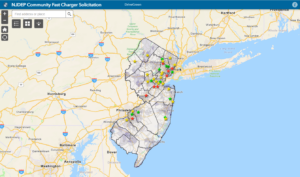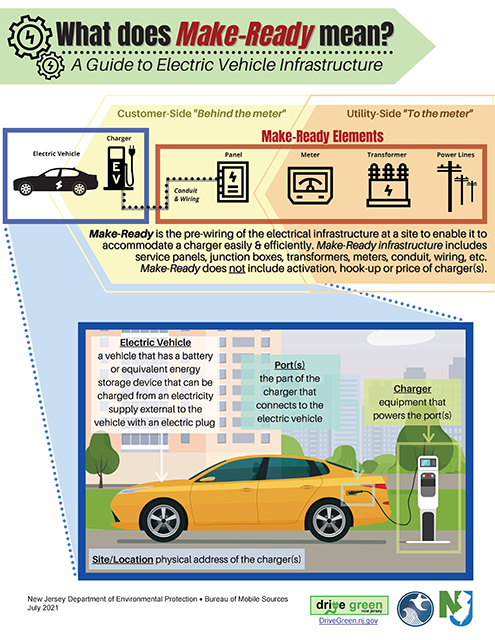
DC Fast Charger Community Solicitation
On August 9, 2022, NJDEP announced the projects that were selected for the DCFC Community Awards. Please see below for a list of selected projects. All Awardees will receive instructions on how to move forward with grant agreements.
Selected Projects
Community DC Fast Charging Selected Projects
- Sussex Borough – Sussex
- Town of Newton – Newton
- DP Management LLC – Hackettstown
- 7-Eleven – Morristown
- Bloom Enterprises LLC – Montclair
- Borough of Waldwick – Waldwick
- eCAMION USA Inc – Edgewater
- Borough of Tenafly – Tenafly
- Village of Ridgefield Park – Ridgefield Park
- Borough of Ramsey – Ramsey
- City of Union City – Union City
- EVgo Services LLC – Elizabeth
- Town of Roselle Park – Roselle Park
- PSQ Holdings LLC – Rahway
- Pluckemin Tiger Mart LLC – Pluckemin
- Faith Lutheran Church – Hillsborough
- City of Lambertville – Lambertville
- Mercer County – Trenton
- Neptune Township – Ocean Grove
- All American Ford – Point Pleasant
- Township of Mount Holly – Mount Holly
- Borough of Collingswood – Collingswood
- Vista 2016 LLC – Voorhees Township
- Pitman Borough – Pitman
- City of Ventnor – Ventnor
- City Cape May – Cape May City
- Universal Electric Vehicle LLC – Egg Harbor Township
- Universal Electric Vehicle LLC – Atlantic City
- Circle Liquor Store – Somers Point
- eCAMION USA Inc – Wildwood
- Fred Harz and Son Inc. – Elmer
Important Links
Community Fast Charger Solicitation Mapping Tool
This mapping shows both current and proposed DCFC locations that are compliant with the EV Law, along with the Community DCFC Location Suitability Score developed for each 2010 Census Tract in the state. It is designed to allow interested parties to browse and select suitable locations for grant-funded DC Fast Charging infrastructure.
Questions and Answers
The program accepted written questions only regarding the solicitation until March 4, 2022.
Please see the following two FAQ documents:
How to apply for a project:
Step 1: Read the Overview and Instructions and visit the System for Administering Grants Electronically (SAGE) to complete your application.
Visit the SAGE Instructions for detailed instructions on how to submit your application via the SAGE portal.
Visit the It Pays to Plug In FAQ for answers to the most frequently asked questions.
Step 2: Obtain three (3) quotes for the EV charging stations.
Step 3: Submit all required documents via the SAGE portal.
Step 4: If the grant application is approved, NJDEP will provide and execute a grant agreement with the applicant via the SAGE portal.
Step 5: Install DC Fast Charging station(s) within 12 months of NJDEP grant execution. Do not purchase or install equipment before your grant has been executed. Completed projects are not eligible.
Step 6: Complete and submit the Expenditure Report and the Charger Information Form via SAGE along with paid invoices, proof of payment, and photos.
Step 7: After NJDEP review and approval of provided invoices, grant funds will be disbursed.
Program Highlights
Eligible Applicants
Private residential dwellings other than multi-unit dwellings are not eligible for grants.
The program is open to all other applicants: Businesses, governments, non-profit organizations, and educational institutions.
Eligible Projects
Community: Charging stations that are exclusively available to the general public in places where people live and work. Examples include, but are not limited to, charging stations in town centers, commercial areas, retail centers, and multi-unit dwellings.
Reimbursement Amounts
Upon completion of work in accordance with the eligibility criteria and grant agreement requirements, NJDEP will reimburse each applicant for a percentage of eligible costs up to a maximum of:
• 150kW+: $200,000 per location (2 port minimum);
• 100 to 149kW: $150,000 (2 port minimum);
• 50 to 99kW: $75,000 (2 port minimum)
| Location | publicly accessible | government property | private property |
| Community | Yes | 100% up to maximum | 80% up to maximum |
DEP grants for EV charging can be combined with utility EV charging infrastructure incentive programs. See the Utility EV Charging Infrastructure Incentive Program below for details.
Selection Criteria
Applicants will be considered after the closing of the competitive solicitation period. Community DCFC locations will be evaluated on the following selection criteria:
• County Tier – Tier 1 Counties will be given priority
• MJ Bradley Tract Score
• Amenities within walking distance
• Distance from Existing/Planned DCFC
• DCFC Power Level
• Other: May include other desirable parameters such as locations near concentrations of MUDs, attractions/destinations, or those with educational value, equipment considerations such as battery storage or utilization of solar power, etc.
UTILITY EV CHARGING INFRASTRUCTURE INCENTIVE PROGRAMS
If the Applicant is participating in It Pay$ to Plug In and a utility EV charging infrastructure incentive program simultaneously, the Applicant must notify NJDEP and the appropriate utility program of dual-participation.
Ask your electric utility about incentives for chargers.
Atlantic City Electric EVsmart Program
Jersey Central Power & Light EV Driven Program
PSE&G Electric Vehicle Charging Program
Rockland Electric EV Charging Program
All Documents
New Jersey utilities have developed load capacity maps to help guide development of electric vehicle charging infrastructure. The maps show areas where new direct current fast charging infrastructure can likely be installed without the need for extensive equipment upgrades. The maps also show areas where capacity may be constrained, and EV charging projects may require major equipment upgrades that could add time and cost.
The maps are for informational purposes only. DEP recommends that customers and developers carefully read and understand utilities’ explanations of the use and limitations of their capacity maps. The maps are not a substitution for the new service application process. Developers and customers must apply to a utility for new service, and be granted approval, before beginning construction or installation of a proposed fast charging project.


